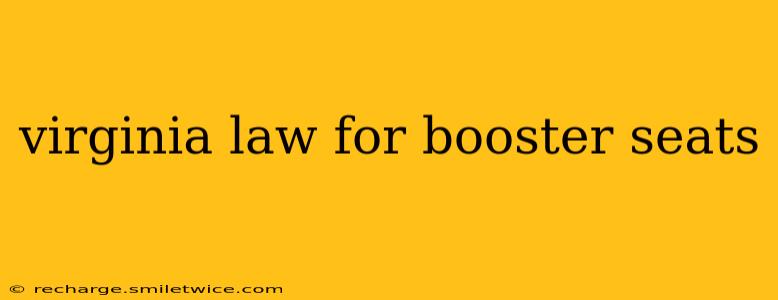Virginia law mandates the use of car seats and booster seats to protect children in vehicles. Understanding these laws is crucial for ensuring your child's safety. This guide will clarify Virginia's booster seat regulations, addressing common questions parents have.
What is the Virginia law regarding booster seats?
Virginia law requires children to be properly secured in a child restraint system appropriate for their age and size until they reach the age of eight. This means that while a car seat is needed for the youngest children, many children will transition to a booster seat before they turn eight. The law doesn't specify a weight or height limit; rather, it focuses on the child's ability to safely use the vehicle's seat belt. A booster seat helps ensure the seat belt fits correctly across the chest and hips, minimizing the risk of injury in a crash.
When can my child stop using a booster seat in Virginia?
A child can stop using a booster seat in Virginia when they meet both of the following requirements:
- They are at least 8 years old: This is the minimum age requirement stated in Virginia law.
- They meet the vehicle manufacturer's height and weight requirements for using the vehicle's seat belt: Each vehicle's manual provides specifications on the appropriate height and weight for using the standard seat belt. The child should be tall and heavy enough for the seat belt to fit correctly across their chest and hips, without riding up on their neck or abdomen.
Simply turning eight isn't sufficient; the child must also meet the vehicle's seat belt requirements. It's always best to err on the side of caution and keep your child in a booster seat until you're certain they meet both criteria.
What are the penalties for not using a booster seat in Virginia?
Failing to properly restrain a child in an appropriate car seat or booster seat in Virginia can result in a fine. The specific amount of the fine may vary depending on the circumstances, but it's a significant deterrent designed to emphasize the importance of child passenger safety.
How do I know if my child is ready for a booster seat?
The transition to a booster seat should be gradual and carefully considered. Look for these signs indicating readiness:
- Outgrowing their car seat: If your child has reached the maximum height and weight limits of their car seat, it's time to consider a booster seat.
- Correct seat belt fit: Have your child sit in the vehicle's seat and try on the seat belt. If it fits snugly across their chest and hips, without riding up on their neck or abdomen, they may be ready.
- Understanding and following instructions: Your child needs to understand the importance of staying seated and buckled during the ride.
It's advisable to consult your child's pediatrician or a certified child passenger safety technician for personalized advice. They can assess your child's individual needs and help you determine the best type of restraint system.
What types of booster seats are available?
There are two main types of booster seats:
- High-back booster seats: These offer more head and side impact protection than backless boosters. They are generally recommended for younger children.
- Backless booster seats: These are lighter and more compact, suitable for older children who have outgrown high-back boosters but still need the extra height provided by a booster.
Are there any exceptions to Virginia's booster seat law?
There may be limited exceptions in specific situations, such as medical conditions. However, it's essential to consult with a physician or law enforcement to determine if such an exception applies. It is always recommended to follow the law and keep children properly restrained.
This information is for guidance only and should not be considered legal advice. Always refer to the official Virginia Department of Motor Vehicles website for the most up-to-date and accurate information on child passenger safety laws. Remember, your child's safety is paramount. Choose the appropriate car seat or booster seat and ensure it's properly installed.
